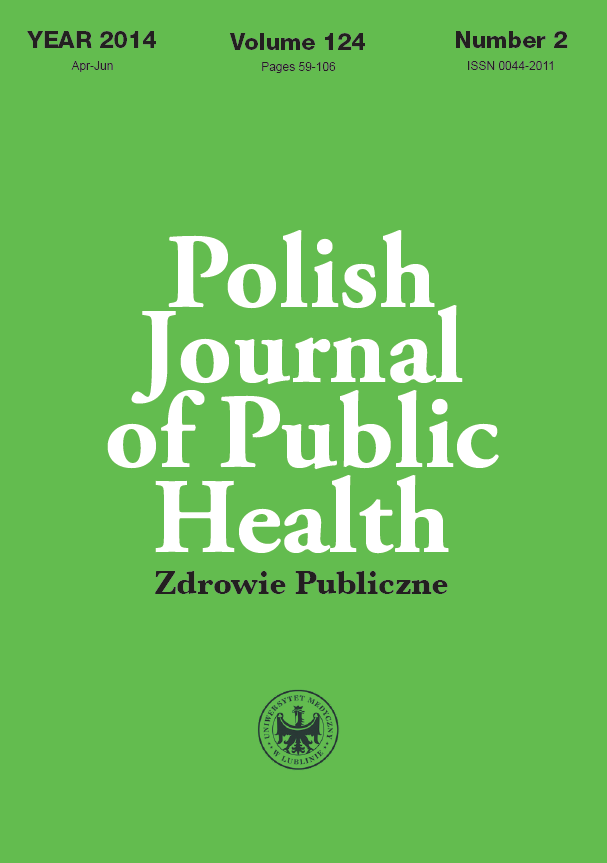Assessment of the dentition in children aged 3-4 years in the Mazowieckie Province
DOI:
https://doi.org/10.2478/pjph-2014-0013Keywords:
dental caries, deciduous teeth, caries frequency, caries prevalenceAbstract
Introduction. Caries of deciduous teeth in the population of Polish children is a significant health, social and organizational problem.
Aim. The aim of the study was to evaluate the dentition of 3- and 4-year-old children in the Mazowieckie Province.
Material and methods. The study comprised 393 kindergarten children aged 3 and 4 years in the Mazowieckie Province, 202 girls and 191 boys, including 159 children aged 3 years and 243 children aged 4 years. In all subjects the state of dentition was assessed. The prevalence of caries was calculated as the percentage of people affected by this disease, and the intensity of dental caries was determined using the dmft index. The results were compared with those that Polish researchers obtained in the 3 – and 4-year-olds after 2000.
Results. In the studied group of 3- and 4-year-olds the prevalence of caries was 62.85%, among girls – 61.88% and among boys – 63.87%. For all subjects the average scores for dmft index were 3.22 and its components dt – 2.72 (decayed teeth), mt – 0.1 (missing teeth), ft – 0.4 (filled teeth).
Conclusions. The prevalence and intensity of dental caries in 3- and 4-year-old children attending kindergartens in the Mazowieckie Province is high and close to the national average. It is advisable to increase the preventive and curative measures in this age group of children on dental caries.
References
1. Olczak-Kowalczyk D. Ocena stanu higieny jamy ustnej i uzębienia u dzieci warszawskich w wieku od 3 do 7 roku życia. Nowa Stomat. 2001;6(4):13-21.
2. Lee Y, Vang W. Predicting caries in permanent teeth from caries in primary teeth; an eight-year cohort study. J Dent Res. 2002;81(8):561-6.
3. Mielnik-Błaszczak M, Michałowski A, Skawińska A, Teleon-Przekora E. Ocena choroby próchnicowej u dzieci w wieku 4-5 lat na podstawie piśmiennictwa i własnych badań klinicznych. Mag Stomatol. 2010;20(9):134-9.
4. Kruszyńska-Rosada M, Borysewicz-Lewicka M. Kliniczna ocena zaawansowania próchnicy zębów mlecznych u dzieci w wieku przedszkolnym. Czas Stomatol. 2000;53(6):345-51.
5. Kaczmarek U, Jankowska E, Sołtan E. Stan uzębienia 4-5-letnich dzieci wrocławskich. Dent Med Probl. 2002;39(2):227-31.
6. Proc P, Filipińska-Skąpska R. Ocena stanu uzębienia oraz stomatologicznych potrzeb leczniczych dzieci łódzkich do lat 5. Nowa Stomatol. 2003;4(26):185-9.
7. Sionkowska J, Wysokińska-Miszczuk J. Ocena stanu uzębienia u 4 i 5-letnich dzieci z małych miast województwa lubelskiego (Chełm). Porad Stomatol. 2007;9:249-53.
8. Szafrańska B, Waszkiel D. Frekwencja i intensywność próchnicy u dzieci w wieku od 3 do 7 lat, mieszkających w Białymstoku. Czas Stomatol. 2008;61(7):480-7.
9. Lisiecka K, Barczak K, Szych Z. Próchnica wczesna u dzieci uczęszczających do szczecińskich żłobków. Mag Stomatol. 2009;19(2):62-4.
10. Szymańska J, Szalewski L. Próchnica zębów mlecznych w populacji polskich dzieci w wieku 0,5-6 lat. Zdr Publ. 2011;121(1):86-9.


